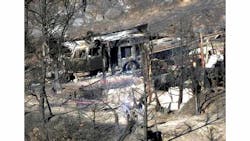Five Firefighters Killed in Esperanza Wildfire Remembered
The morning was cloudy and the air was crisp with a steady breeze rustling the chaparral that punctured the ground.
The group, made up of Rialto Fire Department company and chief officers, had driven through bumpy dirt roads to get to this point. All morning Wednesday, they had been talking about the five firefighters who died in the Esperanza Fire, an arson-caused blaze near Cabazon that burned more than 61 square miles on Oct. 29, 2006.
They had been preparing for this day for months, analyzing the conditions surrounding the fire, the quality and effectiveness of strategic and tactical decisions and identifying steps for fire prevention and how it could apply to the Rialto Fire Department.
As their SUVs made their way up the narrow, rocky, dirt road, they retraced the route Engine 57 took. While the sky was still dark, Engine 57 arrived at the incident command post, ready to jump into action. The had traveled down Wonderview Road toward what is now known as the Octagon House to watch the fire, which had been steadily burning in the creek drainage.
Norm Walker, retired U.S. Forest Service division chief, described the incident as an “area ignition,” when a specific area is spontaneously ignited, and that when he arrived on the scene, the bones of the firefighters were still smoking.
Brian Park, battalion chief for the Rialto Fire Department who attended the training before, said the intent behind the exercise was to make the incident resonate with people and create a personal touch. Each participant was assigned one of the deceased firefighters and told to find out everything about them, including their personal lives and how they died.
When all the SUVs were parked, Fire Chief Mat Fratus talked about the memorial that sat at the bottom of the hill where the incident occurred.
“This is done out of a labor of love, he moved that rock down here himself,” Fratus said. “This guy is very moved by the efforts of these firefighters, almost disturbed that they worked so much and lost so much to save this building. Although there’s a gate, the gate is open because he wants us to learn and make something out of that loss.”
The walk uphill toward the Octagon House was a quiet one. On the side of the pathway to the top, a Steelers lanyard fluttered in the wind, hanging from a small white cross. At the base of the cross lay a small wooden placard that read “MARK,” the name of one of the firefighters, Mark Loutzenhiser, who died.
The firefighters passed by four other white crosses that were erected for Jason McKay, Jess McLean, Daniel Najera and Pablo Cerda.
At the top, they were silent as Walker described the night to them.
The fatal incident happened so fast that the five firefighters didn’t stand a chance against the heat.
“I don’t have an answer to the question that you all are thinking of,” said Walker. “I don’t think you can plan for every fatality situation. Just know that it was real isolated and real rare.”
Walker said that if the same event were to happen tomorrow, he doesn’t know what he would have done differently.
Walking around the Octagon House, the firefighters looked at where the plastic hose left an indelible imprint on the concrete and peered over the side of the hill to get a better view of the creek drainage, trying to envision what that night might have been like.
“What we’re here to do today is to try to make sense to what we learned and I think we did that,” Fratus said at the end of the ride. “What’s important now is that the only way that the rest of the fire department is going to get this is for you to take it back so hopefully this has re-emphasized just how serious our job is and how even more serious wildland is for us than for them because they’re going to do it every day but we’re going to do it every once in a while, but the threat is still the same so when we start next spring, you need to take everything you’ve learned here today and do everything you can to reinforce it because they need to have that emotional connection too. They need to know about area ignition. It’s devastating and it’s hard to imagine.”
———
©2014 the Inland Valley Daily Bulletin (Ontario, Calif.)
Visit the Inland Valley Daily Bulletin (Ontario, Calif.) at www.dailybulletin.com
Distributed by MCT Information Services
